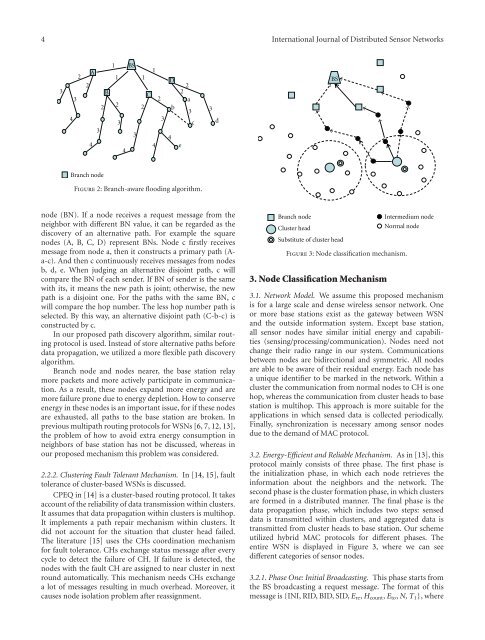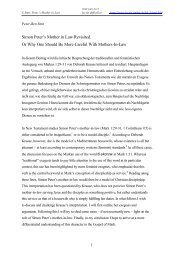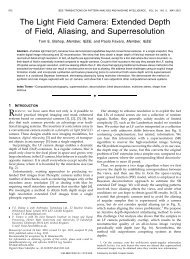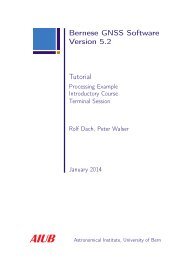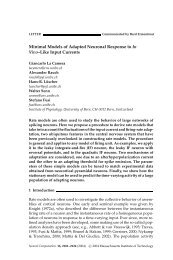Deploying Real-Life WSN Applications: Challenges ... - IAM - CDS
Deploying Real-Life WSN Applications: Challenges ... - IAM - CDS
Deploying Real-Life WSN Applications: Challenges ... - IAM - CDS
You also want an ePaper? Increase the reach of your titles
YUMPU automatically turns print PDFs into web optimized ePapers that Google loves.
4 International Journal of Distributed Sensor Networks<br />
3<br />
4<br />
3<br />
2<br />
1 BS<br />
A<br />
1<br />
1 1<br />
2<br />
B<br />
C<br />
2<br />
2<br />
2 2<br />
3<br />
3<br />
3<br />
3<br />
4<br />
4<br />
4<br />
D<br />
4<br />
b<br />
2<br />
2<br />
a<br />
3<br />
c<br />
e<br />
3<br />
d<br />
BS<br />
Branch node<br />
Figure 2: Branch-aware flooding algorithm.<br />
node (BN). If a node receives a request message from the<br />
neighbor with different BN value, it can be regarded as the<br />
discovery of an alternative path. For example the square<br />
nodes (A, B, C, D) represent BNs. Node c firstly receives<br />
message from node a, then it constructs a primary path (Aa-c).<br />
And then c continuously receives messages from nodes<br />
b, d, e. When judging an alternative disjoint path, c will<br />
compare the BN of each sender. If BN of sender is the same<br />
with its, it means the new path is joint; otherwise, the new<br />
path is a disjoint one. For the paths with the same BN, c<br />
will compare the hop number. The less hop number path is<br />
selected. By this way, an alternative disjoint path (C-b-c) is<br />
constructed by c.<br />
In our proposed path discovery algorithm, similar routing<br />
protocol is used. Instead of store alternative paths before<br />
data propagation, we utilized a more flexible path discovery<br />
algorithm.<br />
Branch node and nodes nearer, the base station relay<br />
more packets and more actively participate in communication.<br />
As a result, these nodes expand more energy and are<br />
more failure prone due to energy depletion. How to conserve<br />
energy in these nodes is an important issue, for if these nodes<br />
are exhausted, all paths to the base station are broken. In<br />
previous multipath routing protocols for <strong>WSN</strong>s [6, 7, 12, 13],<br />
the problem of how to avoid extra energy consumption in<br />
neighbors of base station has not be discussed, whereas in<br />
our proposed mechanism this problem was considered.<br />
2.2.2. Clustering Fault Tolerant Mechanism. In [14, 15], fault<br />
tolerance of cluster-based <strong>WSN</strong>s is discussed.<br />
CPEQ in [14] is a cluster-based routing protocol. It takes<br />
account of the reliability of data transmission within clusters.<br />
It assumes that data propagation within clusters is multihop.<br />
It implements a path repair mechanism within clusters. It<br />
did not account for the situation that cluster head failed.<br />
The literature [15] uses the CHs coordination mechanism<br />
for fault tolerance. CHs exchange status message after every<br />
cycle to detect the failure of CH. If failure is detected, the<br />
nodes with the fault CH are assigned to near cluster in next<br />
round automatically. This mechanism needs CHs exchange<br />
a lot of messages resulting in much overhead. Moreover, it<br />
causes node isolation problem after reassignment.<br />
Branch node<br />
Cluster head<br />
Substitute of cluster head<br />
Figure 3: Node classification mechanism.<br />
3. Node Classification Mechanism<br />
Intermedium node<br />
Normal node<br />
3.1. Network Model. We assume this proposed mechanism<br />
is for a large scale and dense wireless sensor network. One<br />
or more base stations exist as the gateway between <strong>WSN</strong><br />
and the outside information system. Except base station,<br />
all sensor nodes have similar initial energy and capabilities<br />
(sensing/processing/communication). Nodes need not<br />
change their radio range in our system. Communications<br />
between nodes are bidirectional and symmetric. All nodes<br />
are able to be aware of their residual energy. Each node has<br />
a unique identifier to be marked in the network. Within a<br />
cluster the communication from normal nodes to CH is one<br />
hop, whereas the communication from cluster heads to base<br />
station is multihop. This approach is more suitable for the<br />
applications in which sensed data is collected periodically.<br />
Finally, synchronization is necessary among sensor nodes<br />
due to the demand of MAC protocol.<br />
3.2. Energy-Efficient and Reliable Mechanism. As in [13], this<br />
protocol mainly consists of three phase. The first phase is<br />
the initialization phase, in which each node retrieves the<br />
information about the neighbors and the network. The<br />
second phase is the cluster formation phase, in which clusters<br />
are formed in a distributed manner. The final phase is the<br />
data propagation phase, which includes two steps: sensed<br />
data is transmitted within clusters, and aggregated data is<br />
transmitted from cluster heads to base station. Our scheme<br />
utilized hybrid MAC protocols for different phases. The<br />
entire <strong>WSN</strong> is displayed in Figure 3, where we can see<br />
different categories of sensor nodes.<br />
3.2.1. Phase One: Initial Broadcasting. This phase starts from<br />
the BS broadcasting a request message. The format of this<br />
message is {INI, RID, BID, SID, E re , H count , E to , N, T 1 },where


